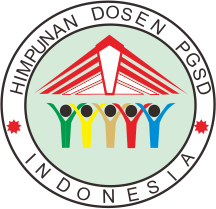PENGEMBANGAN MODEL PEMBELAJARAN TEMATIK SENI DAN BUDAYA MENGGUNAKAN VIDEO TEATERIKALISASI COWONGAN DI SEKOLAH DASAR
DOI:
https://doi.org/10.30595/dinamika.v11i1.5983Keywords:
Cowongan, Dialek Banyumasan, Geguritan, Siswa SDAbstract
This study aims to develop a thematic learning model of art and culture usingvideo theatericalization of “Cowongan” for students in elementary schools. This
research is a research development that aims to improve the ability to verbalize
“Kidung Kasengsaraan Mangsa Ketiga” with the Banyumas dialect. The research
design uses R and D Data collection techniques in research gather information, product
design, product validation, product testing, design revision, trial use, product revision,
mass production, and dissemination. These data sources are interviews, observations,
taking questionnaires, and tests. The sampling technique uses cluster sampling as the
population of SDN 4 Sokanegara students. The results of research in verbalizing the
geguritan include laval, intonation, placement of pauses, and expressions. The
observations of researchers obtained data that the average posttest results that the
experimental class reached 90% of the expected score, while the average control class
reached 75.75% of the expected score. The results of the effectiveness test in the
research prove that the class that uses the product is better than the one that does not
use the product so that the ability to speak up using the Banyumas dialect is more
effective.
References
Amiruddin, 2011, Pengantar Apresiasi Karya Sastra . Bandung: Sinar Baru Algesindo Offset Bandung.
Direktorat Jenderal Guru dan Tenaga Kependidikan. (2016). Bahan Ajar PLPG Materi Keprofesionalan dan Pedagogik. Jakarta
Departemen Pendidikan Nasional. (2008). Panduan Pengembangan Bahan Ajar. Jakarta: Direktorat Jenderal Manajemen Pendidikan Dasar dan Menengah.
Kementerian Pendidikan dan Kebudayaan. (2013). Bahasa Indonesia, Ekspresi Diri dan Akademik. Jakarta: Kementerian Pendidikan dan Kebudayaan.
Khoedri, M,. Banyumas Wisata dan Budaya.(1991).Brebes:.Bumiantik
Maryono, (2015). Analisa tari. Surakarta:ISI Press
Murgiyanto, Sal, (2004). Tradisi dan Inovasi. Beberapa Masalah Tari di Jakarta: Wedatama Widya Sastra.
Badan Pengembangan dan Pembinaan Bahasa Kementerian Pendidikan dan Kebudayaan. (2016), Antologi Cerita Anak berbasis Kearifan Lokal, Jakarta : Badan Pengembangan dan Pembinaan Bahasa Kementerian Pendidikan dan Kebudayaan.
Permendikbud No 67 tahun 2013, Kerangka Dasar Dan Struktur kurikulum SD/MI
Pusat Bahasa Departemen Pendidikan Nasional, 2008. Kamus Besar Bahasa Indonesia ,Jakarta : Balai Pustaka
Prastowo, A, 2012. Panduan Kreatif Membuat Bahan Ajar Inovatif. Yogyakarta: Diva Press
Sugiyono, (2006). Metode Penelitian Kuantitatif , Kualitatif, dan R & D . Bandung: Alfabeta.
Sukiyadi,dkk, (2006). Kurikulum & Pembelajaran . Bandung: UPI Press
Suyanto,dkk,2013. Menjadi Guru Profesional:Erlangga
Riantiarno, N.2011 Kitab Teater Tanya Jawab Seputar Seni Pertunjukkan: Grasindo
Tarigan, Guntur, 2008. Berbicara Sebagai Ketrampilan Berbicara. Bandung: Angkasa
UU NO 20 tahun 2003 tentang Sistem Pendidikan Nasional
Nugroho. Wisnu, 2017, Model Pembelajaran Dick and Carrey , Kajian Linguistik dan Sastra, V ol 1 no 2 Desember , 119-126
Nurdyansyah, & Luly Riananda (2016), Developing ICT –BasedLearning Model to Improve Learning Outcomes IPA of SD Fish Market in Sidoarjo, Proceedings of International Research Clinic & Scientific Publications of Educational Technology, Jurnal TEKPEN , 1 (2),929-930
Suwardi, 27-30 Juni 2005, Bengkel Sastra Jawa,
http://staffnew.uny.ac.id/upload/131872518pengabdian/c1bengkel.pdf
Downloads
Published
How to Cite
Issue
Section
License
Authors who publish with this journal agree to the following terms:
Authors retain copyright and grant the journal right of first publication with the work simultaneously licensed under a Creative Commons Attribution License that allows others to share the work with an acknowledgement of the work's authorship and initial publication in this journal.
Authors are able to enter into separate, additional contractual arrangements for the non-exclusive distribution of the journal's published version of the work (e.g., post it to an institutional repository or publish it in a book), with an acknowledgement of its initial publication in this journal.
Authors are permitted and encouraged to post their work online (e.g., in institutional repositories or on their website) prior to and during the submission process, as it can lead to productive exchanges, as well as earlier and greater citation of published work (See The Effect of Open Access).

Dinamika Jurnal Ilmiah Pendidikan Dasar is licensed under a Creative Commons Attribution 4.0 International License.













